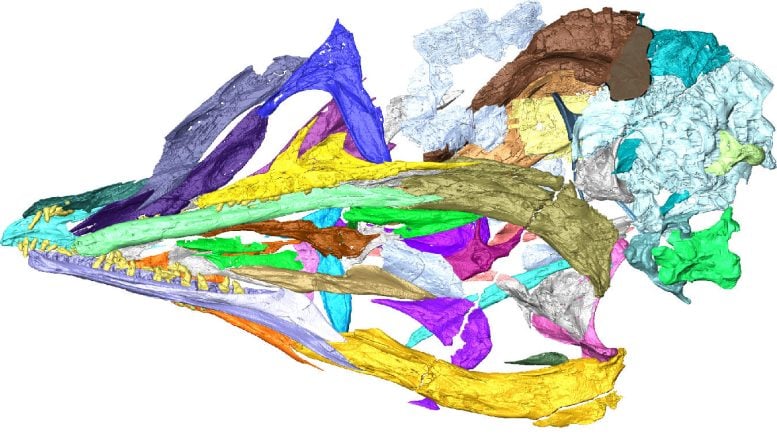
Digital reconstruction of the skull of the Cretaceous bird Yuanchuavis kompsosoura. Credit: Wang Min
A new study from researchers at the Institute of Vertebrate Paleontology and Paleoanthropology of the Chinese Academy of Sciences and the Field Museum of Natural History has found that birds retained key dinosaurian characteristics for millions of years after the split between dinosaurs and birds.
The study, which analyzed and reconstructed a 120-million-year-old bird fossil called Yuanchuavis kompsosoura, found that this ancient bird retained many of the same features as its dinosaurian ancestors. This fossil also offered insights into the origins of cranial kinesis, a key feature in the skulls of modern birds.
The study was recently published in the journal eLife.
Most living birds have what is termed a kinetic skull. This means that upper beak movement is independent of the braincase. This mobility is accomplished by two chains of skull bones aligned from the back of the skull to the front, with one chain along the cheek and the other along the palate (roof of the mouth). These chains of interconnected bones help to transfer forces from the back of the skull to the beak, allowing for its movement.
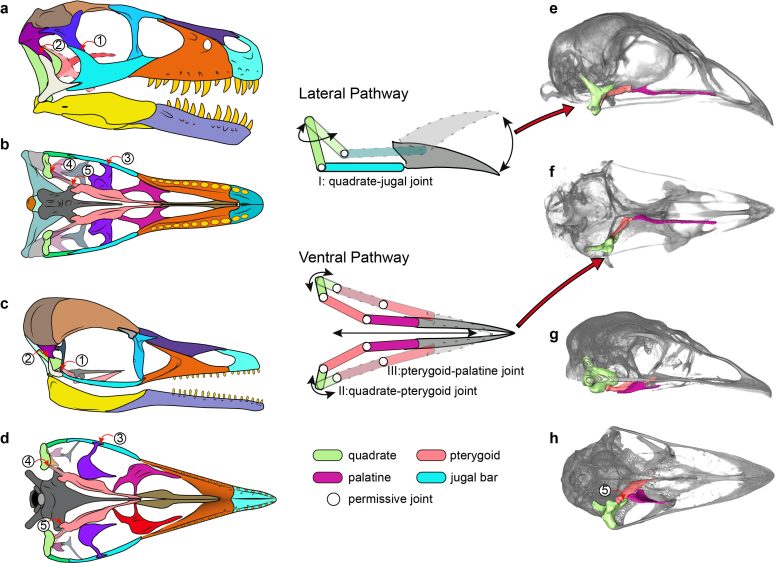
Comparison of skull morphology of dinosaurs, Yuanchuavis, and modern birds, demonstrating that key components of the two chains of skull bones critical for cranial kinesis are lacking in Yuanchuavis and dinosaurs. Credit: Wang Min
“We still don’t know which chain of bones was completed and freed first in bird evolution, or even if it was all completed together,” said Professor Wang Min from IVPP, lead and corresponding author of the study. “What we see in dinosaurs and the earliest birds like the enantiornithine Yuanchuavis is that these chains are missing connections or are locked in place because they connected to more bones that would stop most movements.”
“This fossil actually helps to narrow the time when, and where on the bird family tree, components of that moveable beak or kinesis evolved. We can show that it definitely was not present any earlier in bird evolution,” said Professor Thomas Stidham from IVPP, coauthor of the study.
Yuanchuavis is a member of a group of extinct birds called enantiornithines or “opposite birds”—so named because of key differences in their skeleton from living birds. The enantiornithines became extinct at the end of the Cretaceous during the global mass extinction marking the end of the Age of Dinosaurs.
Digital reconstruction of the skull of the Cretaceous bird Yuanchuavis kompsosoura. Credit: Wang Min
By using high-resolution CT-scanning, the research team was able to digitally identify, isolate, and assemble all skull bones into a detailed three-dimensional reconstruction. This work revealed many anatomical details not known for early birds. Yuanchuavis shows a mosaic of dinosaurian and bird traits such as a feathered bird body with wings, a toothed mouth, and an immovable dinosaurian palate and snout.
Among the primitive dinosaurian features of Yuanchuavis is the presence of bar-forming contacts among the bones of the temporal region of the skull behind the eye that are found in dinosaurs, crocodiles, lizards, and snakes (known as the diapsid condition). These interconnections essentially “lock up” one of the chains of bones in Yuanchuavis that is otherwise free in living birds, a requirement for kinesis.
The researchers’ detailed study of the shape of the pterygoid, a palate bone, shows that it had no direct contact with another bone called the quadrate, which is also needed to complete the palatal chain of bones in kinesis. That absence of contact is seen in most dinosaurs, including Triceratops and Tyrannosaurus, but the bones connect with one another in living birds.
In addition, the research team was able to confirm that the pterygoid of enantiornithines retained a unique shape. It had a two-pronged projection behind the eye like Velociraptors and other close dinosaurian relatives of birds.
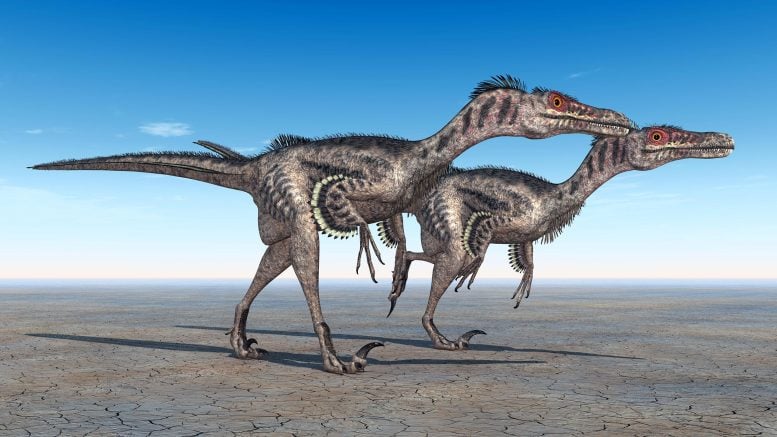
Furthermore, the study’s team confirmed that the pterygoid of enantiornithines maintained a distinct shape. It featured a two-pronged protrusion behind the eye, similar to Velociraptors and other dinosaurs closely related to birds.
Although these features ruled out any kinesis in the skull of early birds, the paleontological team was able to uncover a secret hidden in the fossil skull regarding the origin of kinesis. Detailed analysis and comparison of the palatine, another bone in the palate of Yuanchuavis, shows that the palatine lacks a key contact with the jugal bone, a part of the cheekbone. Dinosaurs and the oldest bird Archaeopteryx have that contact, which helps stabilize the palate bones and restricts movement. In contrast, the palatine of living birds, like Yuanchuavis, does not have that contact, thus facilitating back-and-forth sliding during bird skull kinesis.
According to Professor Wang, the change in palatine bone shape from having contact with four to just three other skull bones in enantiornithines may be where skull kinesis began.
“New features evolve from old ones, and kinesis must have evolved in birds from an ancestor lacking it,” said Professor Wang.
Professor Stidham observed that most people would expect early birds to have bird skulls that matched their feathered wings and bodies. “However, these early birds hadn’t completely moved beyond their dinosaurian ancestry, and the evolutionary path from a small feathered dinosaur to a living bird was not a straight line,” he said, noting that bird evolution had its “detours and dead-ends.”
Reference: “Insight into the evolutionary assemblage of cranial kinesis from a Cretaceous bird” by Min Wang, Thomas A Stidham, Jingmai K O’Connor and Zhonghe Zhou, 5 December 2022, eLife.
DOI: 10.7554/eLife.81337

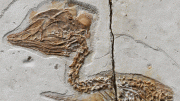

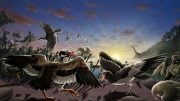


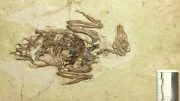
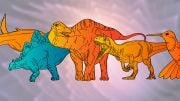
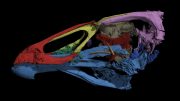
Tabloid news again early birds lack flight skull from modern birds but like modern bird its true bird velociraptor is true bird but was a flightless bird that ancestor was a flying bird like all flightless birds it’s not a dinosaur .dinosaur is a thecodont animal crocodilian animal thecodont is just another name for crocodilian dinosaur was allways crocodilian they have no links to birds the gator is most advance dinosaur ever it’s improve spinosauridae the mesoeucrocodylia dinosaur.The cliam the skull yuanchuavis is like early dinosaur with akinetic skull were is evidence for this advance primitive bird .how can you not say this bone the bone for kinesis skull the vomer bone the vomer science. In reptile this bone is not fuse on reptile it is fuse in modern crocodilian because link to full palate that why they say gator palate is simular to mammal only dinosaur have a full palate spinosauridae t.rex type theropod .bird mammal gator have a fuse vomer all thou call reptile vomer it is not a vomer it’s prevomer it need a new scientific name or call it prevomer only fuse vomer is call vomer .bird have a vomer because it has kinesis skull the maniraptoran oviraptoran has vomer because it’s a bird not a dinosaur that is start there evolution to kinetic skull and bird do not have a full palate they do not need won there breathing system is won of best in animal kingdom probaly is number one the palate is heavy not good for flight the bird skull muscle the mandibular fenestra hole this muscle is reduce in birds because mobile upper jaw that why they can get rid of mandibular fenestra in thecodont it is design to kill bigger animal so no reducing .that why they test dinosaur bite force they use modern crocodilian not birds because there no link with birds and dinosaur allso tail testing with armor dinosaur with club tail only use crocodilian because they is no link with dinosaur and birds . The r kinesis for archaeopteryx oviraptor low kinesis but is better than dinosaur its more simular to modern birds dromaeosaur kinesis is worst than archaeopteryx oviraptor because of bone block in modern bird they are missing many Bones from archaeopteryx they have flight skull less heavy bones but problem is they weak skull predator can easy kill it but the best defendsive weapon is flight which is good defendsive weapon the scientist use flight skull to end cliam that flightless bird did not come from a flying ancestor. On vomer the low part is contact the pterygoid parasphenoid in modern bird only parasphenoid in dinosaur there is no contact because skull is akinetic like and there is no link with dinosaur and bird that why skull is so different there is no stand in for birds in dinosaur test .gator skull fully akinetic like mammal so fuse vomer is not connect to kinesis skull in bird skull is fully kinetic and lack a full palate the palate early birds like velociraptor archaeopteryx and modern bird chicken are the same only different is vomer because prokinesis skull of modern bird less vomer and less palatial complex that the different from birds from dinosaur the palatial complex vomer palatine pyterygoid .bird pterygoid is different from reptile .reptiles do not have prequadrate wing of the pterygoid in later bird is in contact with the quadrate .in modern bird palatine become bigger than archaeopteryx .in crocodilian mammal they have 6 bones fuse to braincase a highly akinetic skull.the links for evidence pnas vomer evolution zoological journal tenth archaeopteryx.